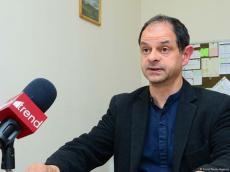Today.Az » Society » UNFPA expert: Demographic transition to be one of smoothest in Azerbaijan
17 April 2019 [10:00] - Today.Az

By Trend
Demographic transition is expected to be one of the smoothest in Azerbaijan, Robert Ivan Gal, who will be responsible to build capacity of relevant government agencies to create National Transfer Accounts (NTA) in Azerbaijan, said in an exclusive interview with Trend. “National Transfer Accounts (NTA) add the age component to the national accounting system. NTA deals with the entire economy, but it describes the economy as flows among people of different age. Attention is paid to old people. We are working on NTA project in Azerbaijan. Some policy proposals will be based on the results of that project. Then it is up to the Azerbaijani authorities to decide on future plans,” he said. Talking about the process of creating NTA in Azerbaijan, Robert Ivan Gal said that it is about rearranging the relevant statistical data. “We rely on official statistics, which is provided by the State Statistical Committee. I am advising the local team here. What they will do, is to rearrange the existing Azerbaijani data. They will not produce new data. Azerbaijan in this respect is an easy place. The administrative capacities of the statistical services are at very high standards. They produce a wide range of statistical output and at a very high quality. We had the basic training in the last two days. We expect the first results and the first draft report by the end of the year,” he said. The expert also pointed out that for the foreseeable future, the demographic transition seems to be one of the smoothest in Azerbaijan. He congratulated with the birth of the 10 millionth citizen of Azerbaijan. Further, he talked about the demographic situation in the world with special focus on population aging. “Population aging is a natural process. It is frequently described as a threat. Less people in active age have to support more of the elderly, because the population is shrinking, it is aging and so it is described frequently as a threat. Sometimes proposals are aimed at preventing it. But population aging brings a lot of benefits and it reflects very positive developments. It means that we live longer and healthier. That seems to be something good. When population was young, that was because people died young. Even in the most developed countries 200 years ago many people didn’t reach the age of 1 or 5, because they died as infants or small children. Now most people, who are born, reach the age of 60. This is a very positive development, but it creates an aging population,” said Robert Ivan Gal. Meanwhile, he noted that the population aging is the result of better technology and better education system. “For the same reason, not only the average length of life increases, but the time that people can spend in useful employment. If we are faced with the extended life time, we can design policies that would extend the working life, too. Then we would have older societies, high-age societies, but the proportion of those, who are vulnerable and need support would not increase,” the expert added. Robert Ivan Gal went on to add that population aging is the combination of two factors: longer life and declining fertility. “At the same time, life expectancy is increasing and this does not necessarily mean threat for social balance. Decreasing fertility also creates an opportunity. If fertility decreases, people save the labor, and the revenues that were spent on children. They can decide to use that amount in three ways: one is that they consume that and have an easier life. That is a short-sighted strategy. That will definitely lead to problems on the long run. However, they can also decide to invest more in children. They have less children, but those children will be more productive in the future, because they get better education, they will be raised in better health and the human capital will not decrease. The third way is to invest for the future in financial or physical capital. Then you will have resources to finance your old age,” he explained. Retuning to NTA, he noted that it gives a kind of statistical framework for wise policy-making and allows for the development of new indicators, with one of them being the support ratio. “In fact, the currently used version of the support ratio that compares only the sizes of age-groups, such as the number of people between the ages of 20 and 64 to the number of those above the age of 65, is very artificial. It changes across the countries. In some countries people become old later and in some other countries they become old at the younger age; and this cutting age changes over the time. If you have less children, but they are better educated, then they work more efficiently, have higher wages and can support the elderly more easily. The NTA-based version of the support ratio takes that into account as well. With the help of NTA, we can develop indicators that describe the aging process much better. And all such calculations show that if human capital investment is increasing, we keep people longer in the schools and give them the chance for more efficient work,” said the expert. He pointed out that there are numerous cases when advisory bodies recommended this strategy of preparing for population aging and use the numbers of this accounting. “Twenty years ago it started as a small working group in the US and now, it covers about 80 countries around the world. The statistical standard of NTA was adopted by the UN. There is already a country, South Korea, which puts this statistical practice into the annual official routine,” Robert Ivan Gal concluded.
/t_UNFPA1.jpg)
/t_UNFPA2.jpg)
/t_UNFPA3.jpg)
/t_UNFPA4.jpg)
/t_UNFPA5.jpg)
|